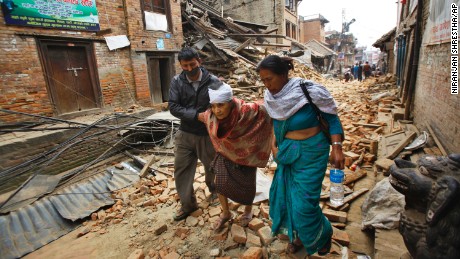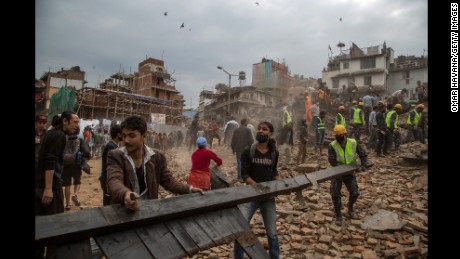Story highlights
- Journalist Sunir Pandey was visiting relatives with Nepal's 7.8 magnitude quake struck
- He says they ran to shelter under a concrete beam and prayed, as dust rose from the rubble
Sunir Pandey is a freelance journalist who previously worked as a correspondent for the Nepali Times, an English-language weekly in Kathmandu.
Kathmandu, Nepal (CNN)When the earthquake struck, we huddled under a concrete beam -- and prayed.
In another room, my grandfather could not comprehend what was happening and, instead of seeking cover, drifted towards the window.
Outside, a brown dust-cloud rose from the ruins of cottages that had dotted the next hill.
I was at my uncle's place in Ramkot, west Kathmandu, some 12 kilometers (7.4 miles) east from my family home.
After escaping the building for the safety of open air, my first thought was for news of friends and family. Calls didn't go through but thankfully texts and data did. I heard from everyone except my mother.
Worried sick, I foolishly went into the house for a second time to get my belongings and leave for home.
Another tremor -- the first of many to aftershocks that have continued to strike an already traumatized city -- shook the house.
I took refuge under the same doorway.
Map of destruction
The journey towards my family home in Sifal was a map of quake destruction, with many houses -- old and new -- torn apart.
A high wall surrounding a monastery had collapsed and the nuns had run to a nearby field. A mud-and-brick cottage had fallen on a blue motorbike but no trace could be found of its rider.
A woman perched on top of rubble tried to reach for a water container from what used to be her kitchen.
Everywhere, survivors gathered wherever they could find open space -- fields, private compounds, empty roadside lots.
In Chhauni, an ice cream seller ran double-time with his cart, while his radio relayed the latest. Further ahead, a mother and daughter sat down on a pavement so that a grandchild could be fed.
Across the Bishnumati River, uphill towards Maru, I ran to get away from the tall houses and made towards the Kathmandu Durbar Area. It was reduced to rubble.
A blood donation camp was said to be buried by the same structure that sheltered it. Locals were searching for survivors, but progress was slow.
Temples destroyed
The Kasthamandap temple had caved in. Temples that sat on impressive staircase-style pyramids were now dust.
The western fa├¦ade of the Basantapur palace had fallen apart and nothing remained of the remained of the nine-story medieval palace nearby.
Meanwhile, the curio fleamarket was flooded with people who had made it out of the cramped quarters of Jhocchen, Indra Chowk, New Road, and nearby neighborhoods.
In Putalisadak, I met a cousin who was sitting an entrance exam for a prestigious high school when the quake hit before the allotted time was over. He kept wondering out loud whether he could retake the test.
The two of us walked through Bagbajar, trying to trace a few acquaintances, and up Dillibajar to Kamalpokhari.
A hawker was selling momos -- a Nepalese type of dumpling -- under a seven-story building, while policemen guarded a jailhouse.
People gathered mostly in the middle of crossroads, on traffic islands and around metal pulpits, which looked out of range of falling buildings. The aftershocks kept coming.
Family home intact
I reached home and found both my parents alive and uninjured. I couldn't believe that our 30-year-old house was still standing.
As I walked my cousin to where his parents were, we kept hearing rumors: "More quakes forecast by experts for 5 p.m. and midnight."
As if to confirm, tremors shook us at six and more would follow at 10 p.m. and midnight, with smaller shocks throughout the night.
Along the northern boundary of the former royal museum, the wall had collapsed and people had poured out of the Uttar Dhoka neighborhood onto the palace lawn.
Green military tents meant for two people were now packed with six and the army was trying hard to accommodate as many as possible.
In Thamel, an electricity pole had squashed an abandoned taxi. A few men took turns taking photos with the wrecked car.
In Kantipath, a handful of backpackers were discussing where to make camp. Back home, my parents decided against going to the nearby Sifal Chaur football field where families were sleeping on plastic mattresses under rudimentary tents.
Instead, their tactic was to stay on the ground floor, be awakened by tremors, and then scamper to a corner of our garden that seemed relatively safe.
I did not sleep a wink.











































































































































